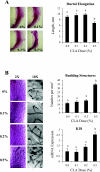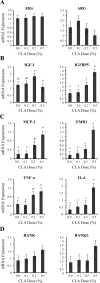t10,c12-CLA decreases adiposity in peripubertal mice without dose-related detrimental effects on mammary development, inflammation status, and metabolism
- PMID: 20844263
- PMCID: PMC3007182
- DOI: 10.1152/ajpregu.00445.2010
t10,c12-CLA decreases adiposity in peripubertal mice without dose-related detrimental effects on mammary development, inflammation status, and metabolism
Abstract
The trans 10, cis 12-conjugated linoleic acid (10,12-CLA) isomer reduces adiposity in several animal models. In the mouse, however, this effect is associated with adipose tissue inflammation, hyperinsulinemia and hepatic lipid accumulation. Moreover, 10,12-CLA was recently shown to promote mammary ductal hyperplasia and ErbB2/Her2-driven mammary cancer in the mouse. Reasons for detrimental effects of 10,12-CLA on the mouse mammary gland could relate to its effect on the mammary fat pad (MFP), which is essential for normal development. Accordingly, we hypothesized that mammary effects of 10,12-CLA were mediated through the MFP in a dose-dependent manner. Female FVB mice were fed 10,12-CLA at doses of 0%, 0.1%, 0.2%, or 0.5% of the diet from day 24 of age, and effects on mammary development and metabolism were measured on day 49. The 0.5% dose reduced ductal elongation and caused premature alveolar budding. These effects were associated with increased expression of inflammatory markers and genes shown to alter epithelial growth (IGF binding protein-5) and alveolar budding (TNF-α and receptor of activated NF-κB ligand). The 0.5% dose also caused hyperinsulinemia and hepatic lipid accumulation. In contrast, the 0.1% 10,12-CLA dose had no adverse effects on mammary development, metabolic events, and inflammatory responses, but remained effective in decreasing adipose weights and lipogenic gene expression. These results show that a low dose of 10,12-CLA reduces adiposity in the mouse without negative effects on mammary development, inflammation, and metabolism, and suggest that previously reported detrimental effects relate to the use of excessive doses.
Figures





Similar articles
-
Nutritional supplementation with trans-10, cis-12-conjugated linoleic acid induces inflammation of white adipose tissue.Diabetes. 2006 Jun;55(6):1634-41. doi: 10.2337/db06-0036. Diabetes. 2006. PMID: 16731825
-
Combined effects of rosiglitazone and conjugated linoleic acid on adiposity, insulin sensitivity, and hepatic steatosis in high-fat-fed mice.Am J Physiol Gastrointest Liver Physiol. 2007 Jun;292(6):G1671-82. doi: 10.1152/ajpgi.00523.2006. Epub 2007 Feb 22. Am J Physiol Gastrointest Liver Physiol. 2007. PMID: 17322064
-
The t10,c12 isomer of conjugated linoleic acid stimulates mammary tumorigenesis in transgenic mice over-expressing erbB2 in the mammary epithelium.Carcinogenesis. 2007 Jun;28(6):1269-76. doi: 10.1093/carcin/bgm018. Epub 2007 Jan 27. Carcinogenesis. 2007. PMID: 17259656 Free PMC article.
-
t10,c12-Conjugated linoleic acid stimulates mammary tumor progression in Her2/ErbB2 mice through activation of both proliferative and survival pathways.Carcinogenesis. 2008 May;29(5):1013-21. doi: 10.1093/carcin/bgn035. Epub 2008 Mar 13. Carcinogenesis. 2008. PMID: 18339686 Free PMC article.
-
Development of conjugated linoleic acid (CLA)-mediated lipoatrophic syndrome in the mouse.Biochimie. 2005 Jan;87(1):73-9. doi: 10.1016/j.biochi.2004.11.006. Biochimie. 2005. PMID: 15733740 Review.
Cited by
-
Trans-Fatty Acid-Stimulated Mammary Gland Growth in Ovariectomized Mice is Fatty Acid Type and Isomer Specific.Lipids. 2017 Mar;52(3):223-233. doi: 10.1007/s11745-016-4221-2. Epub 2017 Jan 10. Lipids. 2017. PMID: 28074319 Free PMC article.
-
A proof of principle clinical trial to determine whether conjugated linoleic acid modulates the lipogenic pathway in human breast cancer tissue.Breast Cancer Res Treat. 2013 Feb;138(1):175-83. doi: 10.1007/s10549-013-2446-9. Epub 2013 Feb 16. Breast Cancer Res Treat. 2013. PMID: 23417336 Free PMC article. Clinical Trial.
-
Dietary conjugated linoleic Acid and hepatic steatosis: species-specific effects on liver and adipose lipid metabolism and gene expression.J Nutr Metab. 2012;2012:932928. doi: 10.1155/2012/932928. Epub 2011 Aug 22. J Nutr Metab. 2012. PMID: 21869929 Free PMC article.
-
Liver x receptors stimulate lipogenesis in bovine mammary epithelial cell culture but do not appear to be involved in diet-induced milk fat depression in cows.Physiol Rep. 2014 Mar 27;2(3):e00266. doi: 10.1002/phy2.266. Print 2014. Physiol Rep. 2014. PMID: 24760520 Free PMC article.
-
Fatty Acids and Breast Cancer: Make Them on Site or Have Them Delivered.J Cell Physiol. 2016 Oct;231(10):2128-41. doi: 10.1002/jcp.25332. Epub 2016 Feb 16. J Cell Physiol. 2016. PMID: 26844415 Free PMC article. Review.
References
-
- Bauman DE, Perfield JW, 2nd, Harvatine KJ, Baumgard LH. Regulation of fat synthesis by conjugated linoleic acid: lactation and the ruminant model. J Nutr 138: 403–409, 2008 - PubMed
-
- Bhattacharya A, Banu J, Rahman M, Causey J, Fernandes G. Biological effects of conjugated linoleic acids in health and disease. J Nutr Biochem 17: 789–810, 2006 - PubMed
Publication types
MeSH terms
Substances
LinkOut - more resources
Full Text Sources
Research Materials
Miscellaneous

